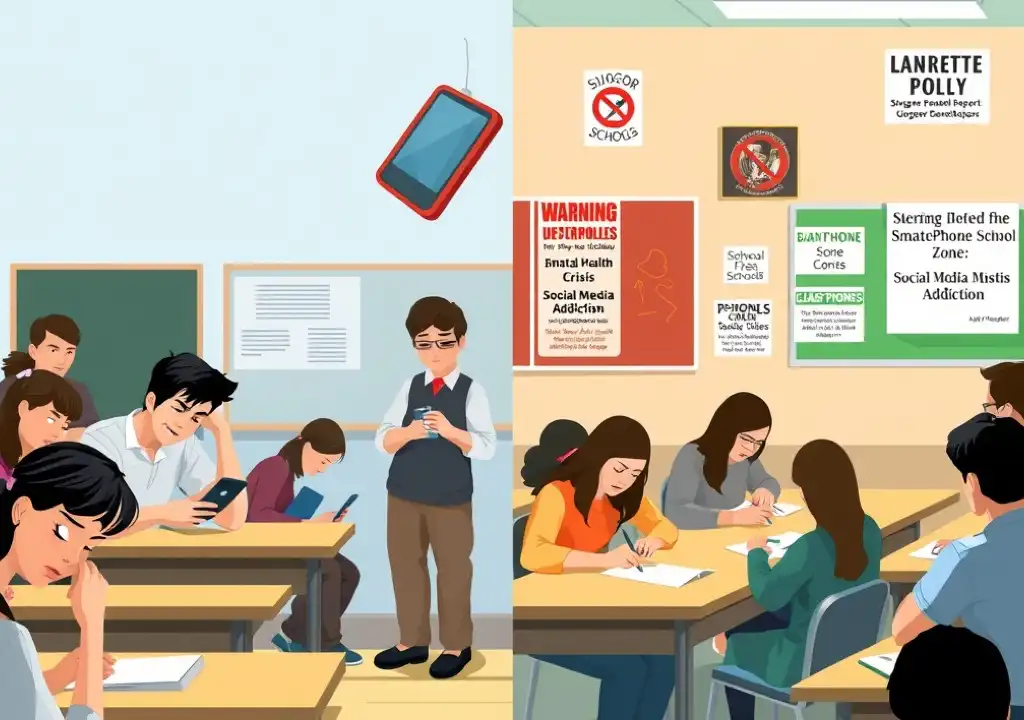Experts highlight growing concerns about the impact of smartphones on youth mental health – but does removing them from schools help?
A rising number of states, cities, and school districts in the United States are limiting smartphone use in public schools amid intensifying discussions about the impact of social media and technology on children and teens.
The Los Angeles Unified School District Board, which oversees nearly 1,000 schools, recently passed a motion to craft a policy banning student use of mobile phones and social platforms during school hours. The policy is due within 120 days but won’t take effect until 2025. A 2019 California law allows school districts to impose phone restrictions during school hours except in emergencies.
“Kids should be paying attention to learning while in school, not distracted by screens,” said Governor Gavin Newsom on June 19.
US Surgeon General Dr. Vivek Murthy recently proposed adding warning labels to social media platforms, similar to those on tobacco or alcohol, due to their mental health risks.
“Social media is linked to significant harm in adolescent mental health. A warning label, though it would need congressional approval, would serve as a constant alert to families that these platforms aren’t proven safe,” Murthy wrote in The New York Times.
Where Else Have Smartphones Been Banned in the US?
States like Florida, Indiana, Ohio, and Oklahoma have already rolled out policies restricting smartphones in public schools.
Indiana’s Senate Bill 185, signed by Governor Eric Holcomb in March, prohibits device use during class and took effect on July 1.
In Ohio, Governor Mike DeWine enacted House Bill 250 last month, directing schools to limit mobile use to reduce distractions. Implementation is left to school districts, with exceptions for emergencies.
“This gives students the chance to fully engage in learning and socializing with peers,” DeWine stated.
In February, Oklahoma’s Senate approved Bill 1314, banning student phone use on school campuses.
“Being a regular kid again, free from social media drama, is important,” said Florida Governor Ron DeSantis after passing a similar law last year. The Florida law bans wireless devices during class hours, restricts student Wi-Fi access, and includes social media literacy in the curriculum.
Though Michigan hasn’t issued a statewide rule, some school districts like Flint have imposed bans on school premises and buses.
In June, New York Governor Kathy Hochul announced plans to introduce a state-wide school phone ban by 2025 to protect youth mental health. New York City had a previous ban lifted in 2015, but now, Chancellor David Banks has indicated a renewed effort to eliminate phones in schools.
“They’re more than a distraction—kids are now addicted,” he said.
Why Are Smartphones Considered a Problem in Classrooms?
A Pew Research Center poll from last November found that 72% of US high school teachers view smartphones as major classroom distractions.
“High school educators especially see cellphones as problematic, compared to only 33% of middle school and 6% of elementary school teachers,” the report noted.
Oklahoma State Representative Chad Caldwell, who introduced the state’s school phone ban, said:
“Without phones, kids are quieter and more attentive to teachers.”
Governor Hochul also emphasized the addictive nature of social media algorithms, describing how they isolate students from real-life interactions and disrupt classroom participation.
What Do Mental Health Experts Say?
Researchers believe the smartphone boom in the early 2010s marked a tipping point for youth mental health issues.
Zach Rausch, a research scientist at NYU’s Stern School of Business, said:
“We’re studying why adolescent wellbeing began dropping sharply between 2010 and 2015, especially among girls. We believe the shift to social media and smartphones is a major factor.”
Jonathan Haidt, author of The Anxious Generation, agrees. His research shows a strong link between phone use and mental health decline.
“Teachers and administrators consistently told me they saw clear connections between phone addiction and falling mental health and academic focus,” Haidt wrote.
He added that educators struggle to keep students engaged, as many seem “permanently distracted.”
Do Phone Bans in Schools Actually Work?
Research remains limited, and experts say the effectiveness of bans is still unclear.
Australian scholars Marilyn Campbell and Elizabeth Edwards conducted a comprehensive “scoping review” of over 1,300 global studies from 2007 to 2023. They identified just 22 relevant studies examining school outcomes before and after phone bans in various countries, including the US, UK, China, Sweden, and Ghana.
Their conclusion: evidence for school phone bans improving outcomes is weak.
Yet, Policy Exchange, a UK think tank, published a May report claiming a “clear connection” between strict phone bans and improved school performance.
Rausch observed that while the adjustment period is tough, many phone-free schools see long-term benefits.
“Schools that eliminate phones often never look back,” he said.
Is Banning Smartphones the Right Move?
Views differ on how best to address smartphones’ effects. Some oppose outright bans, arguing phones are vital tools and removing them ignores deeper issues.
Keri Rodrigues, head of the National Parents Union, said:
“I don’t think bans teach kids the responsible use of technology. We need to help them learn appropriate behavior instead.”
On the other hand, Daisy Greenwell, who co-founded the UK’s Smartphone Free Childhood initiative, supports strict regulation.
“Big Tech is invading childhood. Teachers say phone-related issues are their top concern,” she told Al Jazeera.
Others warn that while banning phones may reduce distractions, it could also strip students of essential learning tools and communication methods.
Campbell pointed out that schools haven’t evolved much in over a century.
“Blaming phones for all our educational and mental health issues is a simplistic view,” she said.
Instead, she and Edwards advocate for school-led decision-making and educating students on responsible phone use.
A regulated approach with clear rules, they suggest, is likely to yield better results than blanket bans.

